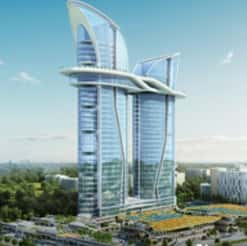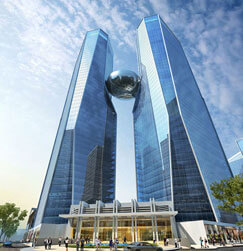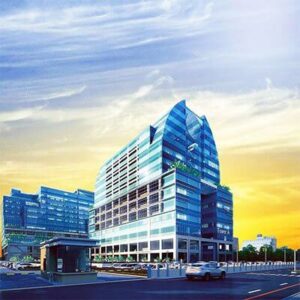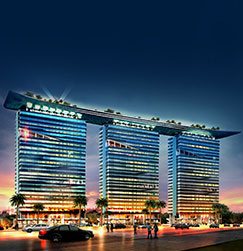In the semiotic fabric of Greater Noida West, there exists a site where architecture transcends utility, where form no longer merely follows function but converses with it in whispered dialogues of ambition. Grandthum, the iconic development that anchors itself not just in geography but in ideology, has unfastened the conventional chains of office architecture and redrafted the blueprint for future-ready work ecosystems. Among the most avant-garde commercial projects in Greater Noida West, it sets a benchmark for visionary thinking.
The twin towers-soaring with G+34 and G+30 elevations-do more than punctuate the skyline. They echo a corporate zeitgeist hungry for expansion yet tethered to cohesion. These vertical monoliths host Signature Office Spaces that articulate an ethos of elevation-not merely in altitude, but in aspiration. Their towering presence is not ornamental hauteur but a deliberate choreography of visibility, stature, and influence.
Within, the architectural grammar dissolves the obsolete rigidity of cubicles. The spatial syntax favours flexibility-encouraging businesses to shape their domains rather than merely inhabit them. Modular layouts, sunlight-kissed glass curtain walls, and wide-span configurations inspire lateral thinking. Office space in Greater Noida West, particularly at Grandthum, is no longer defined by square footage but by strategic flow and cognitive resonance.
Amid the increasing epistemological fatigue around “green buildings,” Grandthum offers a rare antidote: actual performance. Pre-certified Platinum by the Indian Green Building Council (IGBC), its office infrastructure does not greenwash-it green-builds. Photovoltaic rationality, low-flow water fixtures, regenerative elevator mechanisms, and responsive HVAC systems together compose a symphony of ecological prudence.
However, sustainability here is not an accessory but the marrow. Energy conservation is neither aspiration nor advertisement-it is algorithm. The architecture breathes, monitors, adapts. This is infrastructure in dialogue with the climate, not in defiance of it. Grandthum’s commitment to intelligent infrastructure further separates it from traditional commercial projects in Greater Noida West.
Most commercial projects in Greater Noida West tend to bifurcate the human experience-compartmentalizing work and leisure as mutually exclusive. Grandthum abolishes this dichotomy. In its precincts, office space in Greater Noida West is not a silo but a portal to plural experiences. A quick detour from boardroom to waterfront café, from spreadsheets to yacht garden seating—these aren’t indulgences; they are recalibrations of human rhythm.
This nuanced interlacing of amenity and functionality births an ecosystem where burnout is less probable, and balance is structurally encoded. Nightclubs, high-street retail, five-screen multiplexes-these are not peripheral distractions but core design tenets in Grandthum’s psycho-architectural thesis. The site presupposes that holistic employees build holistic enterprises.
To engage with Grandthum’s office space in Greater Noida West is to engage with architecture as an argument. Each corridor, each volumetric void, each acoustic baffle articulates an informed counterpoint to outdated spatial ideologies. Noise, light, texture, and movement are not afterthoughts but elements in a deliberate equation to maximize spatial literacy and cognitive wellness.
This is a place where design does not merely house thought-it accelerates it. Biophilic installations converse with conference tables; sensory calibrations of lighting alter circadian productivity; even walkways evoke a kinetic narrative. Here, space is not a container but a co-conspirator in the business endeavour.
Beyond brick and algorithm, Grandthum offers an infrastructural topology meticulously tailored for modern connectivity. High-speed data provisions, uninterrupted power redundancies, vertical transportation dynamics via high-speed elevators, and mechanically ventilated basements speak to a quiet but formidable robustness beneath the aesthetic veneer.
The real power of Grandthum’s office space in Greater Noida West, however, lies in its ecosystemic intelligence. The entire complex is a mesh of interdependencies-corporate, commercial, and communal-designed not for isolated success but for exponential synergy. Within its sprawl, start-ups converse with conglomerates, ideation interlaces with execution, and ambition finds anchorage in infrastructure.
What Grandthum proposes is more than office space in Greater Noida West-it is the architecture of intention. It resists the temptation to standardize and instead chooses to script a new syntax for commercial existence: one that refuses compromise, fears no innovation, and exalts design as a vector of transformation.
This is not a real estate development. It is an ideological enclave-built brick by brick on the belief that the future of work must be sculpted, not stumbled into. Grandthum invites enterprises not just to operate, but to re-originate themselves-amid towers that scrape not only skies, but the very ceiling of possibility. For those exploring commercial projects in Greater Noida West, Grandthum is not just a destination-it is a declaration.











